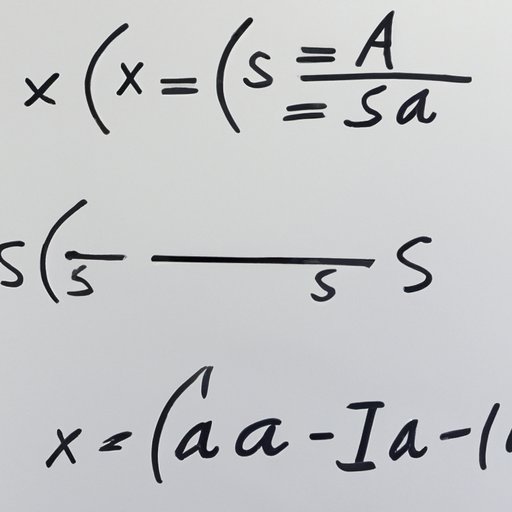
I. Introduction
Mathematics is the study of numbers and their relationships, but it’s also an essential tool for understanding the world around us. Whether you’re calculating the area of a room, designing an algorithm, or modeling a financial system, math is an essential part of the process. One common challenge in math is counting the number of solutions in math problems. This article aims to help you unlock the mystery of finding solutions in math problems.
II. Unlocking the Mystery: How to Find the Number of Solutions in Math Problems
In mathematics, a “solution” typically refers to a value or set of values that make an equation or system of equations true. For example, the equation x + y = 5 has infinitely many solutions, such as (1, 4), (2, 3), or (3, 2). Counting solutions can be important for various reasons, such as finding how many solutions exist for a given problem or determining whether a system of equations is solvable.
There are many methods for finding solutions, such as substitution, elimination, and graphing. Some problems may require more advanced techniques such as partial fraction decomposition or complex analysis. Let’s take a look at some examples.
III. The Ultimate Guide to Counting Solutions in Equations
An equation is an expression that declares that two or more things are equal. Equations can be linear, quadratic, or higher degree, and have one or more variables. Some examples include:
Linear equation: 2x + 3y = 7
Quadratic equation: x^2 – 6x + 8 = 0
Higher degree equation: x^3 + 4x^2 + 5x – 2 = 0
There are various techniques for solving equations, such as factoring, completing the square, and using the quadratic formula. Once you have a solution, it’s important to check your answer to make sure it’s valid. For example, plugging in your solution to the original equation to confirm that it’s true.
IV. Solving for X: Understanding the Various Solutions to Mathematical Problems
Equations can have different types of solutions, such as real, rational, irrational, radical, negative, and complex solutions. For example, the equation x^2 – 5 = 0 has two solutions, x = √5 and x = -√5, which are irrational and negative, respectively. Meanwhile, the equation x^2 + 1 = 0 has two complex solutions, x = i and x = -i, where i is the imaginary unit.
Equations with absolute value can also be challenging to solve, but you can use the properties of absolute value to help identify different cases and simplify the equation before solving.

V. Breaking Down the Different Types of Solutions in Math
Another important distinction in counting solutions is analyzing whether an equation or system of equations has one solution, no solution, or infinitely many solutions.
Graphing can be a helpful tool to determine the number of solutions for a given equation or system of equations, by looking at the points where two graphs intersect. Matrices are another useful tool for solving systems of equations, and you can determine the number of solutions by looking at whether the matrix is singular or non-singular.
VI. From One to Infinite: A Comprehensive Look at Counting Solutions
The degree of an equation or system of equations can also influence its number of solutions. Higher degree equations, such as cubic or quartic equations, can have one, two, three, or four solutions. You can also encounter limits and asymptotes in higher degree equations, which can provide information about the behavior of the equation as the input approaches certain values.
VII. Mastering the Art of Determining Solutions in Algebraic Equations
Algebraic equations are equations that involve one or more algebraic expressions, such as polynomials or rational functions. There are various techniques for solving algebraic equations, such as factoring, completing the square, using the quadratic formula, or solving a system of equations. Once you have a solution, it’s important to check your answer to make sure it’s valid.
VIII. A Beginner’s Guide to Understanding the Number of Solutions in Mathematics
If you’re new to mathematics, counting solutions can be a daunting task. However, with practice and understanding of the various techniques and types of solutions, you can master this essential skill.
To summarize, counting solutions in math problems is important for various reasons, from finding how many solutions exist for a given problem to determining whether a system of equations is solvable. To do so, you need to understand the different types of equations and their solutions, techniques for solving equations, and methods for checking your answer.
IX. Conclusion
In conclusion, counting solutions is a crucial skill for any mathematician, scientist, or data analyst. By understanding the various methods and techniques for finding solutions, you can master this essential aspect of math and apply it to real-world problems.
Remember to start by identifying the type of equation and the number of variables, then use the appropriate technique to solve the equation and check your answer to ensure its validity. With practice and patience, you can become a skilled problem solver and unlock the mysteries of math.





